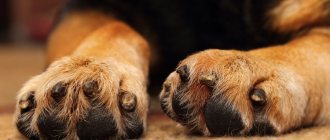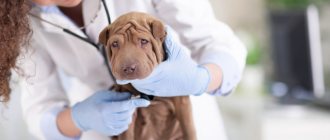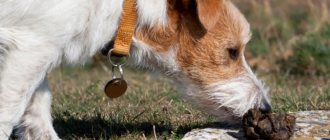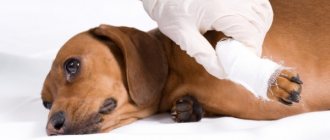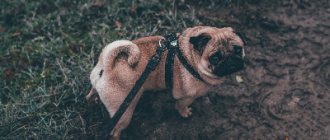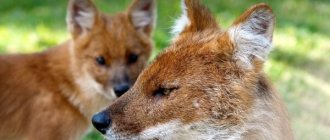Paw licking is one of the most common symptoms veterinarians see. Sometimes pet owners don't even notice that this is abnormal. Only once will the veterinarian ask if a problem has been found. So, how long can a dog normally lick his paws and why might he be licking more than usual?
Dogs clean their paws after they go outside and get wet or dirty. Unlike cats, dogs do not groom themselves on a daily basis and tend to only clean when they are very dirty. So licking, chewing and biting paws at any other time is usually not normal.
Reasons why dogs lick their paws
Dogs lick their paws, paw pads, and between their toes for several reasons. If your dog is a picky dog who likes to groom himself, then most likely he licks his paws when entering the house, after a walk outside, after eating, or sometimes before sleeping. Even dogs that don't groom themselves sometimes clean their paws. If your dog licks his paws regularly but the pads and surrounding areas, including between the toes, appear normal, then there is likely nothing to worry about.
But it is not normal if your dog licks his paws all the time. This is usually a sign of a health or behavioral problem.
Atopic dermatitis
With this pathology, chronic inflammatory skin lesions are noted, caused by various types of allergens that penetrate the body through nutritional, contact, and aerogenic routes.
Symptoms of atopic dermatitis:
- severe itching;
- restless behavior;
- inflamed, reddened skin between the toes and paw pads;
- appearance of wounds, scratches, small rashes on the body4
- mucous discharge from the nose, eyes;
- decreased activity;
- periodic lameness, unsteady gait;
- fast fatiguability;
- inflammation of the nail bed;
- unpleasant odor emanating from the dog’s body and paws.
Health problems and licking of front or back paws
The first step is to determine if there are any paw health problems. Dogs may lick their front or back paws excessively if they are itchy, irritated, or painful.
Damage to the paw or the presence of a stuck foreign object can explain the sudden manifestation of changes in behavior, expressed in paw licking. The dog may have stepped on something causing discomfort. For example, a sharp object or hot pavement. The animal may have been bitten by an insect or other animal. Or is it simply an object or substance stuck or stuck to the paws that requires human help to remove it. Foreign objects such as splinters and pieces of plants can get stuck in the paws and cause irritation.
Another possibility is that the dog has a mass on one of its paws, like a cyst or tumor. Or the dog has arthritis, injury to the soft tissue or bones of the paw. The latter cannot be seen with the naked eye.
A paw injury, foreign object, or swelling is most likely if a dog focuses on one paw more than the others. However, these problems can affect more than one limb at a time.
Allergies often cause the paw pads to become itchy or irritated, causing the dog to lick them excessively. Many dogs have food and/or environmental allergies that cause discomfort in their limbs. Food allergies most often cause itchy paws.
Infections also cause dogs to lick their paws. Many individuals develop bacterial or fungal infections of their paws. These infections can occur for a variety of reasons. However, sometimes they are secondary to allergies. When a dog licks his paws excessively, they remain wet and are more susceptible to bacteria and fungal spores. External parasitic infections, such as fleas or mange, can also cause itchy paws, leading to excessive licking.
If there is no physical reason for your dog to lick his paws excessively, it is acceptable that your dog has behavioral problems.
Additional types of predisposing factors
Of course, the matter is not limited to the above reasons. There are other predisposing factors that provoke the development of a bad habit in a dog:
- Severe neurological pathologies. In particular, this is how some types of pinched nerves manifest themselves.
- Fungal pathologies. Also a very common cause of bad habit. The fungus causes sensations similar to those of allergies. Note that constant licking and an influx of fresh, warm saliva is a real paradise for mushrooms. The more often a dog licks its paw, the worse it becomes, and the faster the source of infection expands.
- Thermal burns. On hot asphalt, a dog can literally bake his paw pads. In winter, accordingly, he can just as easily frostbite them.
- Dermatitis and eczema. In these cases, the inflamed skin also hurts and itches, forcing the dog to somehow drown out these sensations.
- Joint diseases. The same arthritis, for example, causes severe pain to the dog. In order to somehow be distracted and drown out these sensations, the animal can not only lick, but even gnaw and scratch its paws until they bleed.
- Problems with the gastrointestinal tract. Oddly enough, it is precisely when there is pain and other unpleasant sensations in the intestines that animals often lick their paws.
What to do if your dog keeps licking its paws?
If you think your dog is constantly licking his paws, start by taking a good look at them. Inspect the top and bottom of your feet, as well as in between your toes and in and around the balls of your feet. Search:
- Foreign objects
- Cuts
- Bruises
- Bleeding
- Edema
- Redness
- Corky
- Peeling
- Discharge
- Everything else that looks abnormal.
Provide first aid if necessary. Please note that excessive licking may cause drool stains on the coat. They often have a rusty coloration and are especially noticeable where the hair is light.
If you have any doubts, it is important to consult a veterinarian dermatologist, regardless of whether the paws look more or less normal to you or not. Contact me and I can help you identify and rule out possible health problems before you try to solve the problem yourself. To do this, use the contact form or contacts on the website.
The preliminary consultation is completely free. Here I will try to determine whether I can help your dog remotely or whether additional testing or treatment will be required. If I can help remotely, I will offer you an expert assessment of the situation and detailed consultation online or via video. Otherwise, I will offer you an in-person examination or refer you to the right veterinarian. Most often, problems with paw licking are resolved either by a veterinary dermatologist or a veterinary surgeon.
Warning signs
By observing your pet, you can identify several signs that indicate pathology. If they recur regularly, you should contact your veterinarian.
Anxiety
The pet is constantly itching, does not sit in one place, even at night he jumps up to lick or bite his limbs. In the process, he grunts, squeals or growls, spins like a top, runs from place to place. This behavior should alert the dog owner.
Bleeding wounds
Often, after a walk, an animal gets rid of dirt, grass, ice stuck in its fur by gnawing out foreign objects.
If a dog licks and zealously bites into the skin of the limbs, deep wounds and bites remain on it. This is pathological behavior that is not characteristic of a healthy dog.
Stomach problems
Oddly enough, one of the reasons why a dog licks its feet may be problems with the gastrointestinal tract. Licking the limbs is one of the most common symptoms of this problem, as many veterinarians have noticed.
In this way, the dog tries to induce vomiting and thereby make himself feel better. But this will not help for long, so if you find any stomach-related problems in your animal, do not delay your visit to the clinic. The necessary treatment will be prescribed there.
Did you know? There is a phenomenon called "Frito Feet". This is what the West calls dogs that smell distinctly like corn chips. At first, no one took it seriously and thought it was just a dog finding someone's stash. However, as it turned out, this smell occurs due to poorly washed paws on which dirt and bacteria have accumulated.
Allergy
If your pet's paws are itchy, it could be due to an allergy. This problem is quite common - it can occur due to various environmental factors, food or irritants.
Redness, pigmentation, or brown spots from constant licking may be signs of an allergy. Bathing or drying your dog's paws after going outside will reduce allergens.
Hydrocortisone creams or sprays sold for dogs can temporarily relieve the itching, but treatment requires systemic medications (prescription drugs that affect the entire body).
Causes of the disease
The causes of pododermatitis manifest themselves as single or multiple lesions.
For single lesions, the main causes are the following:
- Injuries to the animal's fingers - stone blows, high temperature.
- Foreign bodies in dog tissues - thorns, glass.
- Oncological processes – tumor, plasmacytomas.
Causes of multiple lesions:
- Parasites on a dog's skin - ticks, fleas.
- Fungal skin lesions.
- Allergies – food, household.
- Disorders of the pet’s endocrine system – hypothyroidism, hyperadrenocorticism.
- Lesions of the autoimmune system.
- Exceptional factors in puppy development. German Shepherds, Pekingese, Dachshunds, and Labradors are more susceptible to the disease.
Long claws
Another reason for a dog’s increased attention to its paws may be too long nails. They interfere with the animal and do not allow it to fully play or even just walk, therefore, if the owner does not cut his nails, the dog believes that he himself is able to do this with the help of his teeth.
Of course, a dog’s attempts to do his own manicure look very funny, but teeth are not scissors. Not only will the animal damage its nail plate, but its fingers may also be damaged.
Therefore, if you are wondering why a dog chews its paws, the answer may be claws that have not been trimmed for a long time. So arm yourself with scissors and carefully cut off all the excess.
Inflammation
Red dots may appear on the skin - localized areas of inflammation caused by repeated licking of the skin. This is a reaction to severe itching and often occurs overnight. Hair loss from moist, red, itchy skin is common.
A topical anti-inflammatory and antimicrobial spray designed for dogs may help treat a similar problem on a dog's paw until the cause is determined. Topical hydrocortisone sprays may also help.
Acral licking dermatitis in dogs
Lyubov Nikolaeva, veterinary clinic "Bely Klyk", Moscow The article uses photographs of the author
Acral lick dermatitis, or acral lick granuloma, is a fairly common and often difficult to treat and control disease characterized by compulsive licking of the distal limbs and leading to the formation of a dense, ulcerated plaque, or nodule.
Acral licking dermatitis (ADD) is one of the ten most common skin pathologies in dogs in terms of frequency of occurrence. In one study, this problem accounted for 0.7% of all dog clinic visits (out of 2,322 consultations) and 2.9% of dermatology consultations.
Etiology and pathogenesis
ADV-like lesions have been detected not only in dogs, but also in exotic animals and zoo inhabitants, in livestock, and even in humans. But classic acral licking dermatitis occurs specifically in dogs. At the moment, this problem is considered as a primary psychogenic dermatosis or a manifestation of obsessive-compulsive disorder. However, such lesions improve or resolve in only 21–63% (according to various studies) of dogs treated with behavior-correcting treatment. This suggests that not everything can be explained by psychogenic disorders.
Boredom, stress or anxiety most often leads to the development of paw licking and the development of ADV. According to some reports, psychogenic disorders can be observed in up to 70% of cases of such granulomas. The most common situation is when such dogs are left alone for a long time. Enclosure dogs that do not have contact with other animals and see the owner only from time to time are often susceptible to ADV. This suggests that lack of social communication is an important factor. Domestic dogs that get little or no walks, little interaction with other dogs, lack of attention due to the birth of a child, the owner's absence due to work or business trips, or even the death of the owner or another animal in the house may also begin to lick their paws.
ADV can also occur as a result of primary diseases accompanied by itching or pain. Among such diseases, it is necessary to consider hypersensitivity reactions, bacterial and fungal diseases, skin neoplasia, demodicosis, trauma, neuropathies and orthopedic pathologies.
The lesions occur as a result of compulsive, repeated licking of an area of skin. As a result of such chronic trauma, damage to the hair shafts and follicles develops (most likely due to indentation of the hair shafts and damage to the hair follicles), and furunculosis often develops.
| Photo 1. Acral dermatitis from licking | Photo 2. Acral dermatitis from licking on the pelvic limb |
| Photo 3. Acral dermatitis from licking on the pelvic limb | Photo 4. Acral dermatitis from licking |
| Photo 5. Beginning of ADV | Figure 6. Several lesions in ADV |
Clinical signs
Large dogs are more likely to develop ADV. It is assumed that there is a genetic predisposition, because There are breeds for which this disease is very typical. The most common breeds are Dobermans, Giant Danes, Labradors, Irish Setters, Golden Retrievers, Boxers, Weimaraners, and German Shepherds. Other breeds and small dogs can also suffer from ADV.
Classic ADV occurs in adult dogs around 2–4 years of age, but can occur at any age. One study observed cases in dogs from 1 to 12 years of age. The older the dog, the more likely it is that several factors, not just psychogenic disorders, influenced the development of the disease. According to some data, the disease occurs twice as often among males as in females.
Lesions are most often single (up to 74% of cases), oval. The sizes vary from 2 to 6 cm. In most cases, lesions are found on the cranial surfaces of the metacarpus and wrist (about 60% of cases). Less common in the region are the metatarsus and tarsus. Sometimes lesions occur on several limbs. Primary lesions are areas of erythema, scaling, exudation, and may not have alopecia. Over time, lesions change. In the chronic course, a characteristic dense, pronouncedly raised plaque with an erosive-ulcerative surface without hair is observed.
| Photo 7. ADV in a dog with allergies | Photo 8. ADV in a dog with atopic dermatitis |
| Photo 9. Licking a limb in a dog with atopic dermatitis | Photo 10. ADV during treatment |
| Photo 11. ADV in a dog with arthritis and arthrosis | Photo 12. Histiocytoma accompanied by itching |
| Photo 13. Trophic ulcer from the bandage (an unsuccessful attempt to protect the paw from licking) | |
Table 1. Triggers/triggering factors for acral dermatitis from licking (according to S. Paterson, 2007)
| Dermatological Localized - true or pseudo-ADV | Trauma, such as a foreign body or a bite. Infection - bacterial, mycobacterial, fungal (kerion) - such diseases are pseudo-ADV, because the lesion itself does not arise primarily from licking. Neoplasia - mastocytoma, histiocytoma, lymphoma (pseudo-ADV). Parasites - demodicosis, reaction to an ixodid tick bite (pseudo-ADV). |
| Dermatological Generalized - usually true ADV | Allergies - atopic dermatitis, food allergies, fleas. Parasites - demodicosis, sarcoptic mange, cheyletiellosis, pediculosis. Endocrinopathies - hypothyroidism, hyperadrenocorticism. |
| Orthopedic Usually, true ADV | Neoplasia - soft tissue or bone, including metastases. Trauma - fractures, dislocations. Infections - especially osteomyelitis. Joint pain - septic or immune-mediated arthritis, osteochondritis. Pain is especially a reaction to implants. |
| Neurological Usually, true ADV. The area of skin defect may correspond to the area of nerve damage | Congenital neurological disorders. Neoplasia of nervous tissue. Lumbosacral degenerative stenosis. Neuritis. Injuries resulting in nerve damage. |
Diagnostics
Despite the fact that in many cases the diagnosis is obvious from the history and clinical examination, a full dermatological examination of the dog is necessary, as with other pathologies. In addition to purely psychogenic factors, other dermatological diseases, as well as neurological and orthopedic diseases, can contribute to the development of the disease (Table 1).
A thorough history can determine if there have been any other complaints about the dog's general health or other symptoms of skin disease to aid in the search for underlying conditions. A detailed survey of the owner often allows you to find out the necessary information about the dog’s lifestyle, its relationships with people and other animals. Analysis of a dog's behavior allows you to more accurately determine the reason for behavioral disorders and find a way out of the current situation.
A dermatological examination is primarily aimed at finding out the nature of the lesion: true ADV or pseudo-ADV, i.e. a lesion caused by other causes, but externally similar to a licking granuloma. The plaque can occur as a result of bacterial or fungal infections, against the background of demodicosis, due to trauma or skin neoplasia. Secondary itching can accompany any of these pathologies, which makes it even more similar to true ADV.
With skin conditions that cause itching, such as food allergies or atopic dermatitis, sarcoptic mange and other parasitic skin diseases, the dog may begin to lick the paw because it feels itchy in the area or because the area is more accessible for licking. A thorough examination of the dog can identify symptoms of other dermatological problems and provide the necessary diagnosis and treatment. If sarcoptic mange is suspected, a trial treatment is used if no mite was found in the scrapings. If allergies are suspected, standard diagnosis is carried out using anti-flea treatments and a diagnostic diet.
If orthopedic or neurological causes of licking are suspected, additional diagnostics are required in the form of an X-ray examination of the limb, joint puncture, computed tomography or magnetic resonance imaging, etc.
X-rays of the limb are also performed in cases where a primary orthopedic disease is not suspected, but a long course of skin pathology could involve deeper tissues and cause periostitis.
The examination of the skin lesion itself includes a mandatory scraping and/or trichoscopy to check for demodicosis and dermatophytosis, a cytological examination of punctate from the plaque and an imprint from the surface. Many dermatologists recommend performing a biopsy and tissue culture for fungi and bacteria at the very beginning of diagnosis to confirm the diagnosis and exclude other pathologies. These tests are mandatory in case of a poor or insufficient response to the prescribed treatment.
A biopsy will be more revealing if the sample is taken from a plaque without an ulcerated surface, involving deep layers of skin, which increases the chances of detecting foci of secondary infection. Half of the biopsy must be sent for bacteriological and mycological examination with subtitles. When taking a sample for culture, it is important to prevent the entry of contaminating microflora: use sterile instruments, carefully remove the top layer of the biopsy with surface changes and bacteria. It is also important not to use antiseptic drugs before collection, so as not to inhibit the growth of bacteria on the medium.
According to one study, histology and bacteriological culture when diagnosing acral lick dermatitis revealed deep bacterial infection in 94% of cases. The bacterial culture data from the surface coincided with the tissue culture data in only 8 cases out of 22. In one of the dogs, a similar study revealed dermatophytosis as the cause of the lesion. According to another review of clinical cases, situations were recorded where mastocytoma and lymphoma were similar in presentation to ADV, in other cases leishmaniasis and sporotrichosis were detected.
Algorithm
Treatment of skin lesions
Successful treatment for acral licking dermatitis depends on how much the primary disease is controlled or behavioral problems are corrected, and how treatable the skin lesions are.
Since deep bacterial infection accompanies ADV in the vast majority of cases, long-term antibiotic therapy is an important part of treatment. The first choice drugs, as in cases of other types of pyoderma associated with coccal microflora, are cephalexin and amoxicillin + clavulanic acid in dermatological doses (22–30 mg/kg every 12 hours). If antibiotics have already been used in treating the animal, but with a poor response to treatment or the drugs have been changed frequently, then it is necessary to select antibiotic therapy based on bacteriological culture with subtitration. For analysis, it is necessary to take material from the plaque by biopsy or puncture, but not from the surface. Antibiotic therapy for ADV usually lasts at least 6–12 weeks.
It is often necessary to use methods that limit licking of the limb, which will shorten the healing time of the lesion. Various types of protective collars or bands can help with this.
For small lesions, especially at the very beginning of their occurrence, glucocorticoids can be used locally. Hormones should be used with caution in cases of severe bacterial infection, so as not to aggravate it. In some cases, the use of hormones may be worth waiting until the bacterial inflammation is resolved, or at least until it is under control. When dense fibrous plaques of small size (up to 3 cm) form, glucocorticoids can be used and injected into the lesion. For large chronic lesions, such methods are usually not effective.
Additionally, a solution of dimethyl sulfoxide can be applied to the affected area in pure or diluted form, as well as in a mixture with an antibiotic or glucocorticoid, because this product is a good “carrier” of ingredients.
In cases of large lesions or chronic scarring that does not respond to medical treatment, surgical treatment may be used. The lesion is removed; the wound on the limb often needs to be closed with a transplanted flap of skin, because It is rarely possible to close the defect with surrounding tissues in this area. Cases of the use of laser surgery in the treatment of such lesions have been described. Many surgeons increasingly prefer this procedure due to less bleeding and tissue damage. Cryosurgery is used less frequently.
There have been isolated publications on the successful use of acupuncture in the treatment of ADV, but the validity of its use requires further research.
Correction of behavioral disorders
Usually, at the beginning of the treatment of acral dermatitis from licking, drugs that correct psychogenic disorders are used. However, the effect of drug treatment may be incomplete or short-lived without eliminating the underlying cause. There are cases of lifelong use of medications if there is no other way to influence the dog’s behavior.
Often the cause of boredom or stress is obvious, and this can be more or less brought under control, for example, by increasing the duration of walks for a dog who spends a lot of time alone. In some situations, you cannot do without the help of an animal psychologist or dog handler.
Examples of reasons that provoke psychogenic licking
- The dog is left home alone all day
- The dog is confined for a long period within a cage, kennel, house
- New animal in the house
- There is another dominant animal in the house
- New baby in the house
- During the hunting period, the bitch is close to the male, but does not have the opportunity to contact him
- The male is close to the female in heat, but has no opportunity to contact her
- New dog in the neighborhood
- Death of a family member
- Death of another pet in the family
- Departure of the owner or children
- Limiting contact with a family member (for example, a child)
- Lack of attention
- Lack of exercise (especially for active hunting dogs)
Of the medicinal methods for correcting behavioral disorders, the most effective and frequently used are antidepressants. The best results are achieved by combining drug therapy and eliminating the stress factor. In addition to antidepressants, drugs that have an anxiolytic effect (for example, hydroxyzine) can relieve compulsive licking. It has been noted that endorphins are produced and released when licking, so some dogs may benefit from endorphin blockers, such as naltrexone. Some drugs are listed in Table 2.
Table 2. Drugs used for psychogenic dermatoses
| Active substance | Oral Dosage in Dogs |
| Amitriptyline | 1–2 mg/kg every 12 hours |
| Doxepin | 3–5 mg/kg every 8–12 hours |
| Fluoxetine | 0.5–2 mg/kg every 12–24 hours |
| Phenobarbital | 2.2–6.6 mg/kg every 12 hours |
| Hydroxyzine | 2.2 mg/kg every 8–12 hours |
Conclusion
Acral lick dermatitis is a very difficult skin disease to treat in dogs. To successfully control this pathology, it is necessary to conduct a thorough search for all predisposing factors and, if possible, eliminate them. It is also important to remember that some diseases can masquerade as this disease. Nevertheless, cases of successful treatment of acral dermatitis are not rare.
Literature
1. WHMiller, CEGriffin, KLCampbell. Small Animal Dermatology, 7th edition, WB Saunders Company, 2012.
2. TLGross, PJIhrke, EJWalder, VKAffolter. Hyperplastic diseases of the epidermis. Skin diseases of the dog and cat: clinical and histopathological diagnosis, 2nd edition. Oxford, UK, Blackwell Science, 2005.
3. AKShumaker et al. Microbiological and histopathological features of canine acral lick dermatitis. Veterinary Dermatology, 19; 288-298, 2008.
4. S.Paterson. Canine acral lick dermatitis. In Practice, 2007.
5. P. Denerolle. Organic diseases mimicking acral lick dermatitis in six dogs. JAAHA, vol.43, 2007.
SVM No. 2/2015
Prevention
Prevention of dog diseases is a series of simple procedures that the owner should carry out regularly:
- Visit the veterinarian for a general examination at least 2 times a year.
- It is mandatory to have all necessary vaccinations from a very early age.
- It is necessary to regularly groom your dog by bathing and brushing it.
- From time to time it is necessary to independently examine the dog for problem areas on its skin.
- Monitor your pet's behavior and mood changes.
Stories from our readers!
“We have always used fertilizers and fertilizers in our garden. The neighbor said he was soaking the seeds using new fertilizer. The seedlings grow strong and strong.
We ordered and followed the instructions. Wonderful results! We didn't expect this! We harvested a wonderful harvest this year, and now we will always use only this product. I recommend trying it."
Psyche
Unfortunately, many dog owners leave their dogs at home for long periods of time. At the same time, the animal experiences stress, suffers from loneliness and boredom.
They find salvation in their own paws, because a monotonous task is distracting, and thus waiting for the owner to arrive becomes less tiring for them.
Why go far, let's remember tips for getting rid of stress for people: reading, knitting, cross-stitching, drawing, etc. These are all monotonous activities that force you to concentrate and thereby relieve stress.
Only dogs can’t do anything like that, so they came up with this type of activity. It is also a unique way to attract attention. After all, when you see your pet chewing its paw, you will immediately begin to say something displeased to him, but he is only glad to have at least some communication from you.
Therefore, do not neglect your dog, but spend more time with it.
Injuries
If your dog suddenly and intently licks one paw, first inspect it to make sure there are no injuries, such as a cut or a torn claw. Perhaps a stone, thorn, glass or other small sharp objects got there. All of the above can sometimes get stuck between the pads. Carefully inspect the nails, areas between the toes and pads, and the tops of the feet.
The dog might have stepped on something sharp.
Your dog may have injured his paw by stepping on something sharp while walking down the road, or developed a blister. In addition, she could have been bitten by a wasp or other insect. Some of these problems can be solved with first aid. You are capable of handling this on your own. While other “troubles” may require treatment from a veterinarian.
